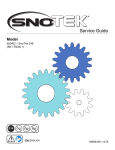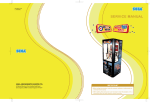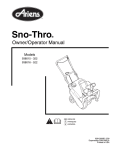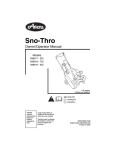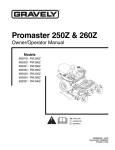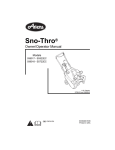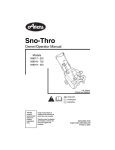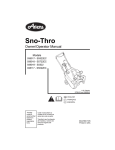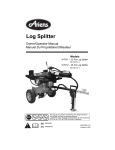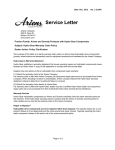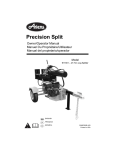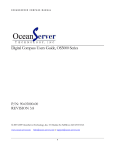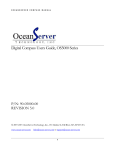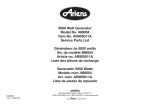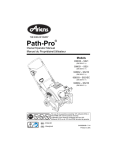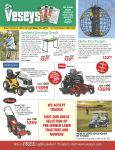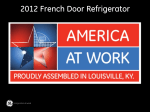Download Ariens Oval Logo.eps
Transcript
TABLE OF CONTENTS Section 1 - Introduction . . . . . . . . . . . . . . . . . 1.1 The Manual . . . . . . . . . . . . . . . . . . . . . . . 1.2 Service and Replacement Parts . . . . . . . 1.3 Product Registration . . . . . . . . . . . . . . . . 1.4 Unauthorized Replacement Parts . . . . . . 1.5 Disclaimer . . . . . . . . . . . . . . . . . . . . . . . . 1.6 Technical Service Communications . . . . . 1-3 1-3 1-3 1-3 1-3 1-3 1-3 Section 2 - Safety . . . . . . . . . . . . . . . . . . . . . . 2.1 Safety Alerts . . . . . . . . . . . . . . . . . . . . . . 2.2 Signal Words . . . . . . . . . . . . . . . . . . . . . . 2.3 Notations . . . . . . . . . . . . . . . . . . . . . . . . . 2.4 Practices and Laws . . . . . . . . . . . . . . . . . 2.5 Required Operator Training . . . . . . . . . . . 2.6 Preparation . . . . . . . . . . . . . . . . . . . . . . . 2.7 Cleaning and Storage . . . . . . . . . . . . . . . 2.8 Safety Rules . . . . . . . . . . . . . . . . . . . . . . 2-4 2-4 2-4 2-4 2-4 2-4 2-4 2-4 2-5 Section 5 - Engine . . . . . . . . . . . . . . . . . . . . . .5-13 5.1 Engine Troubleshooting . . . . . . . . . . . . . .5-13 5.2 Storage . . . . . . . . . . . . . . . . . . . . . . . . . .5-14 5.3 Check Fasteners . . . . . . . . . . . . . . . . . . .5-14 5.4 Clean Engine Cooling System . . . . . . . . .5-14 5.5 Remove Engine . . . . . . . . . . . . . . . . . . . .5-14 Section 6 - Auger and Discharge Chute . . . .6-15 6.1 Auger . . . . . . . . . . . . . . . . . . . . . . . . . . . .6-15 6.2 Discharge Chute Deflector. . . . . . . . . . . .6-15 6.3 Unit Upgrades . . . . . . . . . . . . . . . . . . . . .6-16 Section 7 - Drive Train . . . . . . . . . . . . . . . . . .7-17 7.1 Replace Drive Belt . . . . . . . . . . . . . . . . . .7-17 7.2 Replace Wheels. . . . . . . . . . . . . . . . . . . .7-17 Section 8 - Electrical . . . . . . . . . . . . . . . . . . . .8-18 8.1 Electric Starter . . . . . . . . . . . . . . . . . . . . .8-18 8.2 Sno-thro Cable Routing . . . . . . . . . . . . . .8-18 Section 3 - Specifications . . . . . . . . . . . . . . . 3-7 Section 9 - Chute Crank Kit . . . . . . . . . . . . . .9-20 9.1 Chute Crank Kit . . . . . . . . . . . . . . . . . . . .9-20 Section 4 - General Maintenance & Adjustments. . . . . . . . . . . . . . . . . . . . . . . . 4-9 4.1 Controls and Features . . . . . . . . . . . . . . . 4-9 4.2 Filling The Fuel Tank . . . . . . . . . . . . . . . .4-10 4.3 Service Position . . . . . . . . . . . . . . . . . . . .4-10 4.4 Adjust Discharge Chute Deflector . . . . . .4-10 4.5 Check Clutch Function. . . . . . . . . . . . . . .4-10 4.6 Adjust Auger Controls . . . . . . . . . . . . . . . 4-11 4.7 Adjust Clutch . . . . . . . . . . . . . . . . . . . . . . 4-11 4.8 Impeller Control Cable Adjustment . . . . . 4-11 4.9 Adjust Idler Position . . . . . . . . . . . . . . . . . 4-11 4.10 Adjust Belt Finger . . . . . . . . . . . . . . . . .4-12 2 SECTION 1 - INTRODUCTION 1.1 THE MANUAL 1.3 PRODUCT REGISTRATION It is the purpose of this manual to provide complete instructions for service, maintenance, disassembly, repair, and installation of the mechanical components for the 932 Sno-Thro. A warranty registration card must be filled out, signed, and returned at the time of purchase. This card activates the warranty. Claims meeting requirements during limited warranty period will be honored. Dealer trained service personnel should use this manual as a supplement to and reminder of the training sessions conducted by the company. 1.4 UNAUTHORIZED REPLACEMENT PARTS Use only Ariens replacement parts. The replacement of any part on this vehicle with anything other than an Ariens authorized replacement part may adversely affect the performance, durability, or safety of this unit and may void the warranty. Ariens disclaims liability for any claims or damages, whether warranty, property damage, personal injury, or death arising out of the use of unauthorized replacement parts. Read all information for servicing a part of system before repair work is started to avoid needless disassembly. Operation Before operation of the unit, carefully and completely read manuals supplied with the unit. The contents will provide you with an understanding of safety instructions and controls during normal operation and maintenance. 1.5 DISCLAIMER Directional Reference Ariens reserves the right to discontinue, make changes to, and add improvements upon its products at any time without public notice or obligation. The descriptions and specifications contained in this manual were in effect at printing. Equipment described within this manual may be optional. Some illustrations may not be applicable to your unit. All reference to left, right, front, or rear are given from the operator in the operator position and facing the direction of forward travel. 1.6 TECHNICAL SERVICE COMMUNICATIONS Safety Messages For your safety and the safety of others always read, understand, and follow all DANGER, WARNING, and CAUTION messages found in manuals and on safety decals. 1.2 SERVICE AND REPLACEMENT PARTS When ordering publications, replacement parts, or making service inquiries, know the Model and Serial numbers of your unit and engine. Numbers are located on the product registration form in the unit literature package. They are printed on a serial number label, located on the frame of your unit. Serial Number Ariens Technical Service communicates information to the field using Service Letters, Service Bulletins, Product Notices, and Campaigns. Each communication signifies a type of information and priority. The dealer is responsible to carry out the directive provided in the communication. The types of communication are: Service Letter - General technical information for the dealer. Technical information on how to service the product and product improvements. Service Bulletin - Notification to update products to resolve certain issues or a notification of a policy change. Product Notices - Notification of limited product located in a certain region. This is a limited distribution to only those who received the product involved. Campaigns - Notification of a safety related issue. All product must be updated and are tracked by the factory until all units are corrected. Figure 1 1-3 SECTION 2 - SAFETY 2.1 SAFETY ALERTS rented or sold, ALWAYS provide this manual and any needed safety training before operation. Look for these symbols to point out important safety precautions. They mean: 2.6 PREPARATION Before starting any removal of parts, proper preparation is very important for efficient work. A clean work area at the start of each job will allow you to perform service repairs easily and quickly. Attention! Personal Safety Is Involved! Become Alert! Obey The Message! To reduce the incidence of misplaced tools or parts, place removed components with all attaching hardware in the disassembly order on a clean work surface. Organization is a key part of proper reassembly. 2.2 SIGNAL WORDS The safety alert symbol is used in decals on the unit and with proper operation procedures in this manual. They alert you to the existence and relative degree of hazards. Tools, instruments, and parts needed for the job should be gathered before work is started. Interrupting a job to locate tools or parts is a needless delay. A list of required special tools has been included in this manual. Understand the safety message. It contains important information about personal safety on or near the unit. DANGER: IMMINENTLY HAZARDOUS SITUATION! If not avoided, WILL RESULT in death or serious injury. CAUTION: Remove enough fuel so that no spillage will occur. Remove battery to prevent spillage of electrolyte. WARNING: POTENTIALLY HAZARDOUS SITUATION! If not avoided, COULD RESULT in death or serious injury. 2.7 CLEANING AND STORAGE WARNING: AVOID SHARP EDGES which can cut. Movement of parts can cut off fingers or a hand. Wear gloves, and use extreme caution when servicing. CAUTION: POTENTIALLY HAZARDOUS SITUATION! If not avoided, MAY RESULT in minor or moderate injury. It may also be used to alert against unsafe practices. 2.3 NOTATIONS NOTE: General reference information for proper operation and maintenance practices. IMPORTANT: Specific procedures or information required to prevent damage to unit or attachment. 2.4 PRACTICES AND LAWS IMPORTANT: Never spray unit with water or store unit outdoors to help prevent sealed bearing rust or corrosion. Water can seep into sealed bearings and reduce component life. Bearings are sealed against dirt and debris only. A unit that is excessively dirty should be cleaned before work starts. Cleaning will occasionally uncover trouble sources. Dirt and abrasive dust reduce the efficient work life of parts and can lead to costly replacement. Practice usual and customary safe working precautions, for the benefit of yourself and others. Understand and follow all safety messages. Be alert to unsafe conditions and the possibility of minor, moderate, or serious injury or death. Learn applicable rules and laws in your area. 2.5 REQUIRED OPERATOR TRAINING Original purchaser of this unit was instructed by the seller on safe and proper operation. If unit is to be used by someone other than original purchaser; loaned, 2-4 NEVER fill fuel tank when engine is running, hot, or unit is indoors. When taking unit out of extended storage: 1. Check for any damage or loose parts. Repair, replace, or tighten hardware before operation. 2.8 SAFETY RULES Abnormal Vibrations are a warning of trouble. Striking a foreign object can damage unit. Stop unit and engine. Wait for all moving parts to stop. Remove wire from spark plug. Inspect unit and make any necessary repairs before restart. Walk Around Inspection Hazardous Slopes Complete a walk around inspection of unit and work area to understand: DO NOT operate on steep slopes. Avoid operating on slopes. When you must operate on a slope, travel up and down the slope. Never operate cross a slope. Never operate on a slope greater than 10 degrees. 2. If a preservative fluid was used in fuel tank, drain and discard. Fill fuel tank with fresh new fuel. • Work area. • Your unit. Child Safety • All safety decals. NEVER allow children to operate or play on or near unit. Be alert and shut off unit if children enter area. Work Area ALWAYS check overhead and side clearances carefully before operation. ALWAYS be aware of traffic when operating along streets or curbs. ALWAYS keep hands and feet within the limits of the unit. Keep children, people, and animals away. Keep children out of work area and under watchful care of a responsible adult. Keep area of operation clear of all toys, pets, and debris. Stay alert for hidden hazards. DO NOT run engine in an enclosed area. Always provide good ventilation. Unit ALWAYS keep protective structures, guards, and panels in good repair, in place and securely fastened. NEVER modify or remove safety devices. Personal Safety Only trained adults may operate unit. Training includes actual operation. NEVER operate unit after or during the use of medication, drugs or alcohol. Safe operation requires your complete and unimpaired attention at all times. NEVER allow anyone to operate the unit when their alertness or coordination is impaired. DO NOT operate unit without wearing adequate outer garments. Wear adequate safety gear and protective gloves. Wear proper footwear to improve footing on slippery surfaces. Protect eyes, face, and head from objects that may be thrown from unit. Wear appropriate hearing protection. Operation Avoid Sharp Edges. Sharp edges can cut. Moving parts can cut or amputate fingers or a hand. Wear gloves to service unit when handling sharp edges. Understand: ALWAYS keep hands away from any pinch points. • How to operate all controls • The functions of all controls • How to STOP in an Emergency DO NOT touch unit parts which might be hot from operation. Allow parts to cool before attempting to maintain, adjust or service. Before starting engine, disengage auxiliary power. NEVER place your hands or any part of your body or clothing inside or near any moving part while unit is running. Always back up slowly. Always look down and behind before and while backing. DO NOT wear loose clothing or jewelry and tie back hair that may get caught in rotating parts. Never leave a running unit unattended. ALWAYS shut off auxiliary power, lower throttle setting, and stop engine before leaving unit. ALWAYS remove key to prevent unauthorized use. Keep children and people away from unit during operating. • Speed ranges ALWAYS operate unit in good visibility and light. Fuel is highly flammable and its vapors can explode. Use ONLY approved RED fuel containers. NO Smoking! NO Sparks! NO Flames! Allow engine to cool before servicing. Never direct discharge towards persons or property that may be injured or damaged by thrown objects. Use extreme caution on gravel surfaces. Stay alert for hidden hazards or traffic. Deflected materials can cause injury and property damage. Always stand clear of the discharge area when operating this unit. 2-5 Fumes from engine exhaust can cause injury or death. DO NOT run engine in an enclosed area. Always provide good ventilation. Allow hot parts to cool. Keep unit free of dirt, stones, and other debris. Clean up oil or fuel spills. Service Before cleaning, removing clogs or making any inspections, repairs, etc.: disengage clutch(es), stop unit and engine, remove key, allow moving parts to stop. Allow hot parts to cool. Before tipping unit up onto housing, remove enough fuel so no spills will occur. Ensure unit is secure and will not tip over during maintenance. Fuel is highly flammable and its vapors are explosive. Handle with care. Use an approved fuel container. NO smoking, NO sparks, NO flames. ALWAYS allow engine to cool before servicing. NEVER fill fuel tank when engine is running or hot from operation. NEVER fill or drain fuel tank indoors. Replace fuel cap securely and clean up spilled fuel. ALWAYS maintain unit in safe operating condition. Damaged or worn out muffler can cause fire or explosion. Keep all hardware properly tightened. Cleaning Keep unit free of ice or other debris. Clean up oil or fuel spills. Storage For unit storage or extended storage: • NEVER store with fuel in fuel tank, inside a building where any ignition sources are present. • Allow engine to cool completely. • For extended storage, clean unit thoroughly. See Engine Manual for proper storage. Transport Use extra care when loading or unloading unit onto trailer or truck. Secure unit chassis to transport vehicle. NEVER secure from rods or linkages that could be damaged. DO NOT transport machine while engine is running. Spark Arrester This product is equipped with an internal combustion type engine. DO NOT use unit on or near any unimproved, forest-covered or brush covered land unless exhaust system is equipped with a spark arrester meeting applicable local, state or federal laws.A spark arrester, if it is used, must be maintained in effective working order by operator. 2-6 SECTION 3 - SPECIFICATIONS Model Number Engine Fuel to Oil Mix Fuel Tank Capacity - qt (L) Fast Idle RPM 938001 938002 938301 938302 HSK-600 HSK-850 HSK-850 HSK-600 938301 50:01 50:01 50:01 50:01 1.2 (1.1) 1.2 (1.1) 1.2 (1.1) 4300 3600 4300 3600 4300 N/A 2-Cycle .030/RCJ84 Champion 7.0 x 1.5 7.0 x 1.5 7.0 x 1.5 7.0 x 1.5 7.0 x 1.5 (18 x 3.8) (18 x 3.8) (18 x 3.8) (18 x 3.8) (18 x 3.8) 1200 1200 Installed 73700100 Discharge Distance - ft (m) 3-30 (0.9-9.1) Chute Turning Radius 220o Auger Size (dia) - in (cm) 9.0 (23) 1220 1200 Auger Clutched 1220 Belt Idler Clutched Blower Housing Height - in (cm) 13.25 (33.66) Blower Housing Width - in (cm) Model Number HSK-600 1.2 (1.1) Spark Plug Gap-in (cm)/Type Electric Starter Kit 938006 50:01 Engine Oil Type Auger RPM 938004 1.2 (1.1) Crank Case Capacity - oz (L) Tire Size- in (cm) 938003 22 (56) 73700100 Installed Installed 938007 938008 938009 938303 Engine Fuel to Oil Mix Fuel Tank Capacity - qt (L) Fast Idle RPM HSK-600 HSK-850 HSK-600 HSK-850 50:01 50:01 50:01 50:01 50:01 1.2 (1.1) 1.2 (1.1) 1.2 (1.1) 1.2 (1.1) 1.2 (1.1) 3600 4300 3600 4300 3600 7.0 x 1.5 7.0 x 1.5 7.0 x 1.5 (18 x 3.8) (18 x 3.8) (18 x 3.8) 1220 1200 73700100 Installed N/A Engine Oil Type 2-Cycle Spark Plug Gap-in (cm)/Type .030/RCJ84 Champion 7.0 x 1.5 7.0 x 1.5 (18 x 3.8) (18 x 3.8) Discharge Distance - ft (m) 3-30 (0.9-9.1) Chute Turning Radius 220o Auger Size - in (cm) Auger RPM Auger Clutched 9.0 (23) 1200 1220 1200 Belt Idler Clutch Blower Housing Height - in (cm) 13.25 (33.66) Blower Housing Width - in (cm) Electric Starter Kit 938011 938305 HSK-850 Crank Case Capacity - oz (L) Tire Size- in (cm) 938010 938004 22 (56) Installed Installed 3-7 Installed Model Number 938012 938015 938016 HSK-850 HSK-600 HSK-850 938305 Engine Fuel to Oil Mix Fuel Tank Capacity - qt (L) Fast Idle RPM 50:01 50:01 50:01 1.2 (1.1) 1.2 (1.1) 1.2 (1.1) 3600 4300 3600 Crank Case Capacity - oz (L) N/A Engine Oil Type 2-Cycle Spark Plug Gap-in (cm)/Type Tire Size- in (cm) .030/RCJ84 Champion 7.0 x 1.5 7.0 x 1.5 7.0 x 1.5 (18 x 3.8) (18 x 3.8) (18 x 3.8) Discharge Distance - ft (m) 3-30 (0.9-9.1) Chute Turning Radius 220o Auger Size - in (cm) Auger RPM 9.0 (23) 1200 Auger Clutched Blower Housing Height - in (cm) 1200 13.25 (33.66) Blower Housing Width - in (cm) Electric Starter Kit 1220 Belt Idler Clutched 22 (56) Installed 73700100 3-8 Installed SECTION 4 - GENERAL MAINTENANCE & ADJUSTMENTS 4.1 CONTROLS AND FEATURES 18 19 22 1 15 16 2 23 3 14 21 20 4 5 OS0241 17 6 7 12 11 8 13 9 10 1. Auger Clutch Bail 2. Recoil Starter Handle 3. Handlebar Knob 4. Chute Deflector Handle 5. Exhaust 6. Discharge Chute Deflector 7. Discharge Chute 8. Auger Housing 9. Auger 10.Scraper Blade 11.Discharge Chute Rotation Handle 12.Fuel Tank and Cap 13.Cowl 14.Auger Control Cable 15.Upper Handlebar 16.Lower Handlebar 17.J - Bolt 18.Primer Bulb 19.Ignition Switch 20.Fuel Level Indicator 21.Starter Button (optional) 22.Power Cord (optional) 23.Choke Control Knob OS1500 Figure 2 4-9 4.2 FILLING THE FUEL TANK 4.3 SERVICE POSITION Check fuel level by looking at fuel level indicator on rear of unit. Add fuel as required. Place unit on a flat level surface. 4.4 ADJUST DISCHARGE CHUTE DEFLECTOR WARNING: FLAMMABLE FUEL and its EXPLOSIVE VAPORS can result in death or serious injury. DANGER: ROTATING PARTS will cause serious injury or death. NEVER reach into discharge chute or housing while engine is running. Handle fuel with extreme care. ALWAYS use an approved fuel container. No Smoking! No Lighted Materials! No Open Flames! Allow engine to cool before any service. ALWAYS clean up any spilled fuel. Add fuel to fuel tank: IMPORTANT: Two cycle engines require that oil be mixed with fuel. Failure to mix oil with fuel will result in seizure and severe damage to engine. DO NOT use gasohol or gasoline containing alcohol because alcohol will cause internal parts to deteriorate. See Engine Manual for correct type and grade of fuel. If discharge chute deflector does not stay in set position during operation, adjust chute by tightening fasteners evenly until deflector stays in position. NOTE: Use a T30 torx drive or a 3/16" (.19 cm) wide straight screwdriver to tighten. 1. ALWAYS place unit in open or well ventilated area. 2. Stop engine and allow to cool. Fasteners 3. See engine manual for proper fuel/oil mixture. 4. Clean fuel cap and surrounding area to prevent dirt from entering fuel tank. 5. Remove cap. 6. Fill fuel tank with mixture. Tank capacity is 1.2 quarts (1.1 liters). NOTE: Fuel mixture left standing for prolonged periods will begin to separate; thoroughly shake mixture before use. Figure 3 4.5 CHECK CLUTCH FUNCTION WARNING: FAILURE OF CLUTCHES OR BRAKES may result in death or serious injury. Check clutch and brake function before each use. Repair or adjust before operation. 7. Replace fuel cap and tighten. WARNING: ACCIDENTAL ENGINE START UP can cause death or serious injury. ALWAYS stop engine, remove key, and wait for moving parts to stop before performing maintenance or service. HOT SURFACES can cause death or serious injury. DO NOT touch parts which are hot from operation. ALWAYS allow parts to cool. CAUTION: FUEL SPILLS may result in minor or moderate injury and/or damage to unit. If unit must be tipped, remove enough fuel so that no spills will occur. OS0181 With key in "STOP" position, squeeze auger clutch bail to Engaged position and pull recoil starter handle. Auger should rotate with the turning of the engine. Release the auger clutch bail. If the auger clutch bail moves freely with no resistance before contacting handlebar, adjust or repair. NOTE: The unit will require control cable and/or idler adjustment after 20 hours of operation on a new unit or new drive belt. See Service and Adjustments for instructions. 4 - 10 WARNING: IMPROPER ADJUSTMENT could result in death or serious injury. AUGER BRAKE MUST DISENGAGE when clutch is engaged. BRAKE MUST STOP AUGER WITHIN 5 SECONDS of releasing auger clutch bail. 4.6 ADJUST AUGER CONTROLS WARNING: IMPROPER ADJUSTMENT could result in death or serious injury. AUGER BRAKE MUST DISENGAGE when clutch is engaged. BRAKE MUST STOP AUGER WITHIN 5 SECONDS of releasing auger clutch bail. Locknut Figure 4 OS0011 4.7 ADJUST CLUTCH For brake to function properly, there must ALWAYS be some slight, noticeable slack in the control cable inner wire when the impeller clutch bail is disengaged (lowered position). This allows extension spring to pull idler arm/brake, braking belt. Bail should travel 6-3/4 to 7-1/4" (17.1-18.4 cm) before contacting handlebars on models 938006-938012, 938301, 938303. If brake does not stop impeller within 5 seconds of releasing impeller clutch bail, inner wire slack must be adjusted. 1/4 - 3/8" 1 2 Models 938001-938009, 938301-931303 There should be 1/8" to 3/16" extension of cable spring when clutch bail is held against handlebar. 4 5 Models 938010-938012 3 A properly adjusted clutch must extend control cable Spring approximately 1/4 to 3/8" before clutch bail contacts handlebar. 1. 2. 3. 4. A properly adjusted clutch must show a noticeable increase in resistance (caused by stretch of control cable spring) before impeller clutch bail contacts handlebar. As drive belt seats and wears, increase in resistance will occur closer to handlebar contact. If no resistance occurs, inner wire slack must be adjusted. Control Cable Spring Adjusting Feature Locknut Threaded Section 5. Solid Section Figure 5 OS1220 4.9 ADJUST IDLER POSITION 4.8 IMPELLER CONTROL CABLE ADJUSTMENT The idler must be as close as possible to the drive belt when the auger clutch is disengaged, but not so close that it causes auger rotation. 1. Shut off engine, allow to cool and remove cowl. 2. Loosen locknut on threaded section of control cable adjusting feature (Figures 4 and 5.) 3. Turn solid section to remove almost all slack in cable. 4. Hold the solid section with a pliers and gently, with a small wrench, tighten the locknut. IMPORTANT: If there is still no resistance, the idler position must be adjusted. See Figure 6. 4 - 11 WARNING: ROTATING PARTS can cut off body parts. Keep hands and feet away. Loose clothing, long hair or scarves can get caught in rotating parts and cause death or serious injury. 4.10 ADJUST BELT FINGER To adjust the idler position: IMPORTANT: If adjustment cannot be achieved, the drive belt must be replaced. 3HP units have two belt fingers. 5HP units have one belt finger. 1. Shut off engine, allow to cool, and remove cowl. With the auger clutch engaged, there should be 1/32 to 1/16" (1-1.6 cm) clearance between the belt finger and drive belt. 2. Ensure control cable has some slight, noticeable slack when auger clutch is disengaged (bail in lowered position). To adjust: 3. Ensure belt fingers are properly adjusted. See To Adjust Belt Finger. 1. Loosen bolt holding the belt finger. 4. Loosen idler hardware, reposition idler along slot in idler arm, and tighten hardware. 5. Check for proper extension of control cable spring. See To Adjust Auger Control Cable. 2. Rotate the belt finger around the bolt to the correct position. 3. Tighten bolt. 6. Start engine and ensure auger does not rotate when auger clutch is disengaged. 7. Shut off engine. 8. Repeat the above steps until proper adjustment is achieved. 9. Replace cowl. NOTE: Due to the need for maximum amount of belt tension to operate the single stage sno-thro and the slippage that is encountered with the original belt after the break in period, a new shorter replacement belt has been put into the parts system. This belt has the original belt number but has the letter "A" after the part number. The new belt will allow a longer run time between adjustment intervals. Bail travel should be 4 1/2" to provide proper belt tension. If the 4 1/2" travel cannot be obtained the original bail may be replaced with a bail part #03806351. 1 2 1/32" - 1/16" (1 - 1.6 cm) 3 4 5 5 (3 HP) 1. Idler Arm/Brake 2. Idler 3. Slot 4. Auger Clutch Control Cable 5. Belt Fingers Figure 6 OS0053 4 - 12 SECTION 5 - ENGINE 5.1 ENGINE TROUBLESHOOTING The following troubleshooting chart is to be used to isolate engine problems and give possible causes and corrective action responses. The troubleshooting key is generic for 2 cycle engines and can be used for several types of engines. Use only those possible causes and corrective actions that apply to the unit. TROUBLE Black Exhaust Blue/White Exhaust Difficult Starting Erratic Running Excessive Fuel Consumption Knocking Loss of Power or System Low Cranking Power Misfiring Overheating Poor Compression Starts and Stops POSSIBLE CAUSES (Refer to Key Below) 20, 22, 25, 29, 31, 32, 33 4, 20, 25, 31, 33, 34 5, 8, 10, 20, 21, 22, 29, 31, 32, 33 8, 9, 10, 20, 21, 26, 29, 33, 59, 62 20, 22, 25, 31, 32, 33 22, 26, 29, 31, 33, 36, 46, 59 8, 10, 20, 21, 22, 25, 26, 31, 32, 33 2, 3 10, 20, 25, 26, 28, 29, 32 19, 25, 63 25, 28, 29, 31, 32, 33, 34, 59 6, 10, 62 Vibration Will Not Crank Will Not Start 20, 25, 26, 29, 33, 48, 49 2, 3 6, 8, 10, 21, 22, 62 CORRECTIVE ACTION repair or replace repair or replace repair or replace repair or replace repair or replace repair or replace repair or replace repair or replace repair or replace repair or replace repair or replace repair or replace see electrical systems see engine service manual repair or replace charge battery or replace repair or replace see electrical systems see engine service manual TROUBLESHOOTING KEY 1 2 3 4 Restriction in air cleaner Bad electrical connection Faulty starter motor Incorrect grade of lubricating oil Low cranking speed Fuel tank empty Controls not in correct operation position Blocked fuel feed line Faulty fuel lift pump Choked fuel filter Battery capacity low Air in fuel system 22 23 24 25 Incorrect grade of fuel Sticking throttle/restricted movement Exhaust pipe restriction Leaking cylinder head gasket 43 44 45 46 Faulty suction pipe Choked oil filter Bad solenoid switch Incorrect piston height 26 27 28 Overheating Cold running Incorrect tappet adjustment 47 48 49 29 30 31 32 33 50 51 52 53 54 34 35 36 Worn or damaged bearings 57 Choked breather pipe Damaged valve stem oil deflector (if fitted) Coolant level too low 37 38 Insufficient oil in sump Bad/defective oil temperature switch 58 59 Blocked sump strainer Broken valve spring 18 19 Faulty fuel injection pump Faulty fuel injectors or incorrect type Incorrect use of cold start equipment Faulty cold start equipment Broken fuel injection pump drive Incorrect fuel pump timing Incorrect valve timing Sticking valves Incorrect high pressure pipes Worn cylinder bores Pitted valves and seats Broken, worn or sticking piston ring(s) Worn valve stems and guides Restriction in air cleaner Damaged fan Faulty engine mounting Incorrectly aligned flywheel and/or flywheel housing Faulty thermostat Restriction in water jacket Loose fan belt Choked radiator Faulty water pump 39 40 Oil pump worn Pressure relief valve sticking open 60 61 20 21 Poor compression Blocked fuel tank vent 41 42 Pressure relief valve sticking closed Broken relief valve spring 62 63 Exhaust or vacuum pipe leak Bad or defective water temperature switch Bad spark plug(s) Improper amount of oil in fuel mixture 5 6 7 8 9 10 11 12 13 14 15 16 17 5 - 13 55 56 5.2 STORAGE 5.5 REMOVE ENGINE When storing unit for extended periods of time, remove all fuel from tank and carburetor (run dry). Refer to Engine Manual. 5.3 CHECK FASTENERS 1. Remove gas cap and top cowling. 2. Remove fuel line at the engine and drain fuel into a suitable container. Save for reuse or dispose of properly. 3. Remove drive belt from engine pulley. Keep all nuts, bolts, and screws properly tightened. 4. Remove bolt and washer from engine shaft and slide drive pulley halves from shaft. 5.4 CLEAN ENGINE COOLING SYSTEM 5. Disconnect throttle cable from engine. Engine is air cooled. Air must circulate freely around engine to prevent overheating. Every year (more often if conditions require) remove cooling shrouds and clean cooling fins. Clean external surfaces of engine of dust, dirt and oil deposits which can contribute to improper cooling. Refer to Engine Manual. IMPORTANT: DO NOT operate engine with cooling shrouds removed. Engine overheating and damage will result. 6. On models with recoil starters, unbolt the bracket that holds the recoil handle to the lower handle bar. 7. Remove wiring for key switch. 8. Unscrew bolts from shaft side of engine. 9. Unscrew mounting nuts on recoil side. 10.Disconnect choke cable. 11.Remove engine. Install in reverse order. The engine on the Sno-Thro is a 2-cycle design. The lubricating oil is mixed with the gasoline. Consult the engine manufacturers manual for the proper grade and mix ratio. 1 2 3 1. Hex Bolt 2. Drive Pulleys 3. Engine Mounting Bracket Figure 7 5 - 14 PS0034 SECTION 6 - AUGER AND DISCHARGE CHUTE 6.1 AUGER 6.2 DISCHARGE CHUTE DEFLECTOR The auger consists of two halves bolted together over the auger shaft. (938001, 938003, 938006-938009, 938301, 938303) To replace the auger: If chute deflector does not stay in set position, tighten fasteners evenly until deflector stays in position (Figure 8). Use a #T30 Torx drive or a 3/16" (.19 cm) wide straight screwdriver to tighten. 1. Unscrew the twelve self tapping screws. 2. Remove one half. 3. Rotate second half out. NOTE: The screws tap into a metal plate. Save these for reassembly. 938002, 938004, 938302 Adjust chute deflector control lever pivot bolt nut until the control stays in position. (Figure 9). Check roll pins in auger shaft and replace as needed. When the chute deflector hits its stop for maximum down deflection, the chute deflector control lever should hit its stop on housing at the same time. Assemble in reverse order. Lock in position by adjusting and tightening nuts against bracket. (Figure 9) Discharge chute may freeze in extreme cold conditions and not rotate freely. To correct for this condition the discharge chute handle assembly will need to be removed from the gear discharge chute segment. The pocket in the handle assembly for the spring and ball detent will need to be packed with grease. The metal ring in which the discharge chute is trapped will need a liberal coat of grease as well. 1 3 2 3 4 1. Discharge Chute Rotation Bracket 2. Self-Tapping Bolt Plate 3. Half Auger 4. Auger Shaft Figure 8 PS0063 6 - 15 Figure 9 6.3 UNIT UPGRADES Discharge Deflector Control Force (5HP) 938002, 938004, 938302 The discharge deflector control force is dependent on the bolt through the compression spring in the deflector handle assembly and by the construction of the housing assembly. To correct breakage of the housing alignment pins that go into the handlebar tube, remove them and replace with a flat head screw. The flat head screw will hold the deflector housing securely to the handlebar. The compression spring will then only be required to control the chute deflector lever force. Blower Housing Filling With Snow Snow may enter the engine compartment and get trapped inside with no exiting points. To control the amount of snow that would be trapped inside the engine compartment, two 3" holes will need to be added to the chassis bottom and allow the snow to exit. To control the snow from entering the drive belt area, use 538012 3 HP Update Kit (938001 - S/N 000101 006245, 938003 - S/N 000101 - 002350, 938301 - S/N 000101 -000251) 53801300 5HP Update Kit (938002 S/N 000101 -00 6280, 938004 - S/N 000101 - 003900, 938302 - S/N 000101 - 000241). New holes will need to be drilled for the two additional screws, in the front of the blower housing where the right and left bearing support plates come into contact with the impeller housing. 6 - 16 SECTION 7 - DRIVE TRAIN 7.1 REPLACE DRIVE BELT 7.2 REPLACE WHEELS 1. Remove fuel cap. 1. Support unit with wheels off the ground. 2. Remove cowl and replace fuel cap. 2. Remove hub cap. 3. Disconnect extension spring on idler arm/brake. 3. Pry E-ring clip from shaft. 4. Remove cap screw and washer from end of auger shaft and pull off auger drive pulley. 4. Remove wheel. Assemble in reverse order. 5. Remove old belt. 6. Install new belt onto pulleys. 7. Reinstall auger drive pulley and secure with washer and cap screw. 2 8. Reconnect extension spring to idler arm/brake. 9. Ensure belt finger(s) and auger clutch control cable are properly adjusted. See To Adjust Belt Finger and To Adjust Auger Control Cable in General Maintenance & Adjustments. 1 10.Remove fuel cap and replace cowl. 11.Replace fuel cap. 1 1. Hub Cap 2. External Retaining Ring 1/32"-1/16" (1-1.6 cm) 3 2 4 6 5 7 5 9 1. 2. 3. 4. 5. 8 Extension Spring Idler/Arm/Brake Idler Slot Belt Fingers 6. Auger Clutch Control Cable 7. Drive Belt 8. Auger Drive Pulley 9. Cap Screw, Washer, Auger Shaft Figure 10 OS0053 7 - 17 Figure 11 SECTION 8 - ELECTRICAL 8.1 ELECTRIC STARTER tank neck. Measure 10" of fuel line from carburetor and trim off excess (reference A), see Figure 12. Electric starter is not equipped with a thermal cutout switch. DO NOT crank engine for more than a total of 20 seconds without allowing electric starter to cool down for 10 minutes. Failure to do this can severely damage electric starter. Turn eyelet on top of engine containing the green ground wire to the two o’clock position (reference B) and wrap a 2" piece of electrical tape 2" up from the eyelet, taping the two wires together (reference C). On electric start unit the green wires should be routed over the electric start cable. 8.2 SNO-THRO CABLE ROUTING IMPORTANT: This procedure should be done on all units to prevent wiring from getting caught in the chute crank gears. Place the Sno-Thro on a raised work surface. Remove ignition key, and drain all fuel from the fuel tank. Remove the gas cap and remove the engine cowl part #38005. Retain all hardware for reassembly later. Remove the cable tie from the two green ignition wires and from fuel tank support bracket. Remove the fuel tank from the unit and retain the cable tie around the ref. H chute cable Measure and drill a 1/8" hole in the upper right corner of the engine blower housing 5/8" from each edge (reference D) Figure 13. Cover carburetor before drilling to keep particles out of carburetor throat. Measure and drill a 3/8" hole for the primer hose 2" down and 5/8" out of the corner (reference E). Remove primer hose from carburetor and reroute through the new hole and reattach to the carburetor (reference F), see Figure 12. ref. I cable tie ref. M cable tie ref.A gas line hose ref. E drill 3/8" hole ref. C electric tape ref. B eyelet ref. F primer hose Upper photo of cable routing and anchor point. Figure 12 8 - 18 Install cable clamp onto remote deflector cable 25" from handlebar and at the start of the black protective covering (reference G), see Figure 13. The hole for the clip should be in the down position. Attach the clip to the engine blower housing with the self-tapping screw. Excess cable should be pulled up and out of blower behind discharge chute (reference H). Reinstall fuel tank into Sno-Thro with hardware removed earlier, place cable tie around fuel tank neck with green ignition wires. Check location of green ignition wires to chute crank gear for proper clearance (reference 1) see Figure 12. On 938004, the electric start cable will need to be held in place with a cable tie to clear chute crank gear. Drill a 1/4" hole by measuring 1/4" down and out 1/4" from recess in center of Sno-Thro frame (reference J), see Figure 14. Attach cable ties in the proper locations shown in the photos as references K, L, and M. Recheck cable and wiring routings before reinstalling engine cover. Return machine to stock or customer. ref. L cable tie ref. G install cable clamp ref. D drill 1/8" hole Right side photo of cable routing and anchor point. Figure 13 ref. K cable tie ref. J drill 1/4" hole Rear photo of cable routing and anchor points. Figure 14 8 - 19 SECTION 9 - CHUTE CRANK KIT 9.1 CHUTE CRANK KIT Instructions 1. Remove cowl from unit by loosening 8 screws at lower front sides. Remove two screws at rear corners and remove fuel cap. After removing cowl, replace fuel cap to avoid spills and fumes. (for use on models 938010, 015, 016, 305) WARNING: FAILURE TO FOLLOW INSTRUCTIONS could result in personal injury and/or damage to unit. 2. Install flange bushing in discharge chute rotation bracket with flange toward centerline of chute. Then hold the 18 tooth chute pinion in place in front of the bushing by rolling it in place in mesh with the chute gear. The identification marks on pinion and gear must line up with each other, see Figure 15. Read, understand, and follow all safety practices in Owner/Operator Manual before beginning. View alignment marks through this slot. 7 6 8 1 2 3 1. 2. 3. 4. 4 5 1 Pinion-Discharge Chute 18 T Flange Bushing Crank Pinion 12 T Chute Crank Shaft 5. 6. 7. 8. Internal Hair Pin Chute Assembly Crank Knob Crank Gear 48 T Figure 15 space and tooth identification marks. Align if necessary. Insert cotter pin (taped to chute crank assembly) through 48T gear and chute crank shaft. Minor movement of the crank Shaft or discharge chute handle may be needed to align holes. Rotate chute crank to access cotter pin and secure pin by bending ends over. Reinstall nut, securing chute crank and starter handle brackets to lower handle bar. 3. Install the 12 tooth pinion on the transfer shaft so that the drive tang/stops are seated in the notches in the pinion. Insert the shaft through the hole in the chassis, through the flange bushing and finally through the 18 tooth chute pinion. Align the hole in the shaft with the holes in the pinion. Install the small hair pin through the holes so that it seals over the hub of the pinion. 4. Remove nut from bolt that holds recoil starter Handle bracket in place. Install the chute crank assembly beneath the lower handlebar by starting end through hole in chassis. Hold crank spacer and then 48 tooth gear in place, sliding only as far as needed to get them started. With crank knob straight up and discharge chute straight forward, check that 48T gear meshed with 12T pinion at OS1650 5. You will note that too much effort is required to rotate the chute. To reduce that effort, remove the three bolts that hold the discharge chute onto the ring and remove the chute. Then remove the four screws that attach the ring to the chute gear, and remove the ring. Now you can remove the detent ball and spring and replace the above parts in 9 - 20 neck of the fuel tank with the large tie-wrap. The wires and primer hose must be held together with the small tie-wrap. Turn the crank stop-to-stop several times to ensure there is no rubbing or pinching possible. reverse order. Check to ensure that the gear and pinion marks have not lost their alignment from step 2. 6. Great care must be taken to ensure that the ignition switch wires, primer hose, and electric starter cable (if applicable) do not rub on or become entangled in the chute crank gears. The electric start cable must be secured with the medium tie-wrap to the corner of the chassis. The ignition switch wires must be tie-wrapped to the 7. Remove the fuel cap, install the cowl and fasten in place with all 10 screws. 8. Replace fuel cap. Space and Tooth Identification Marks 6 4 3 5 1 1. Crank Spacer 2. Crank Gear 48 T 3. Lower Handlebar 2 4. Recoil Starter Handle Bracket 5. Chute Crank Bracket 6. Chute Crank Assembly Figure 16 9 - 21 IS0211 Ariens Company 655 West Ryan Street P.O. Box 157 Brillion, WI 54110-0157 920-756-2141 Fax 920-756-2407 www.ariens.com






















